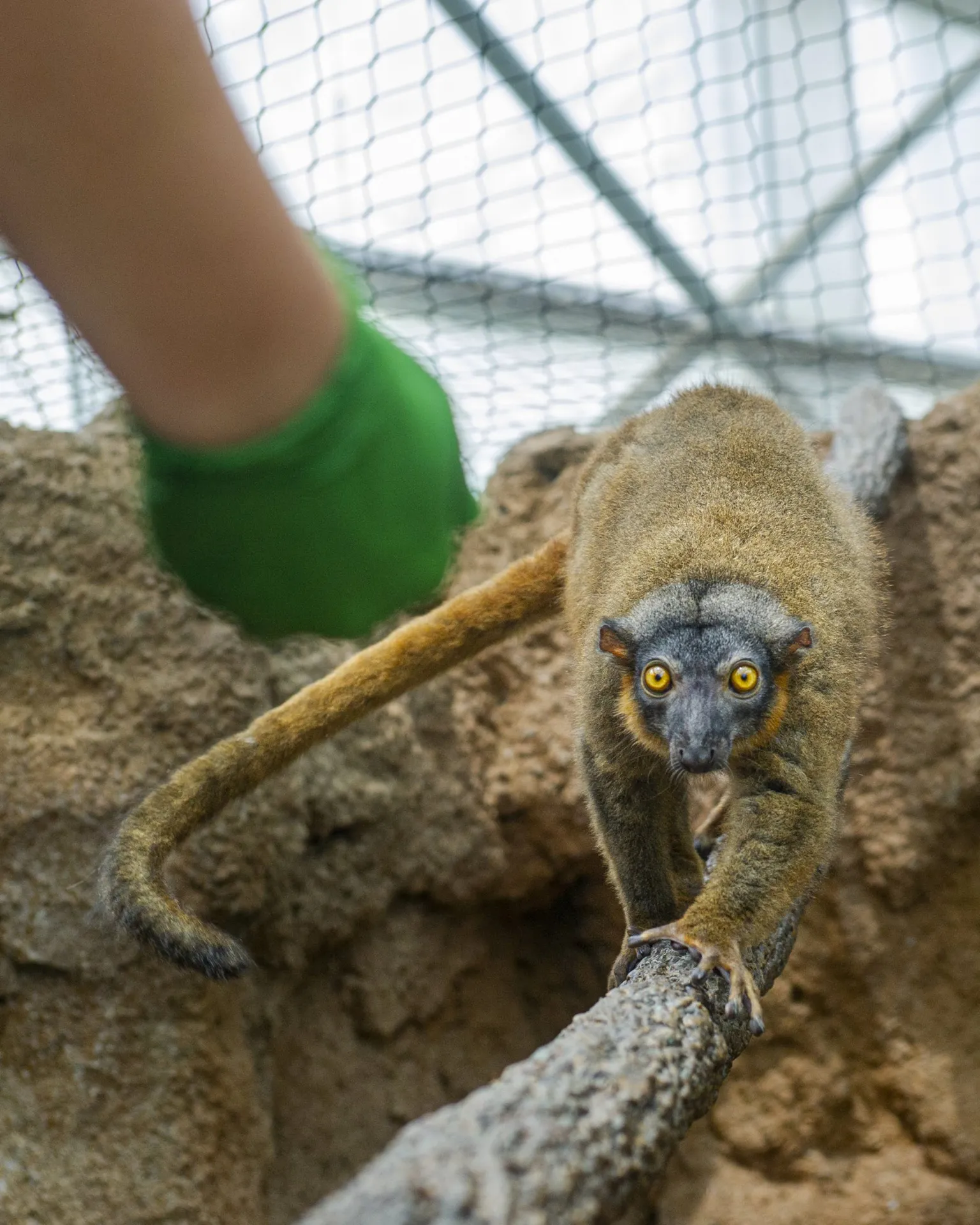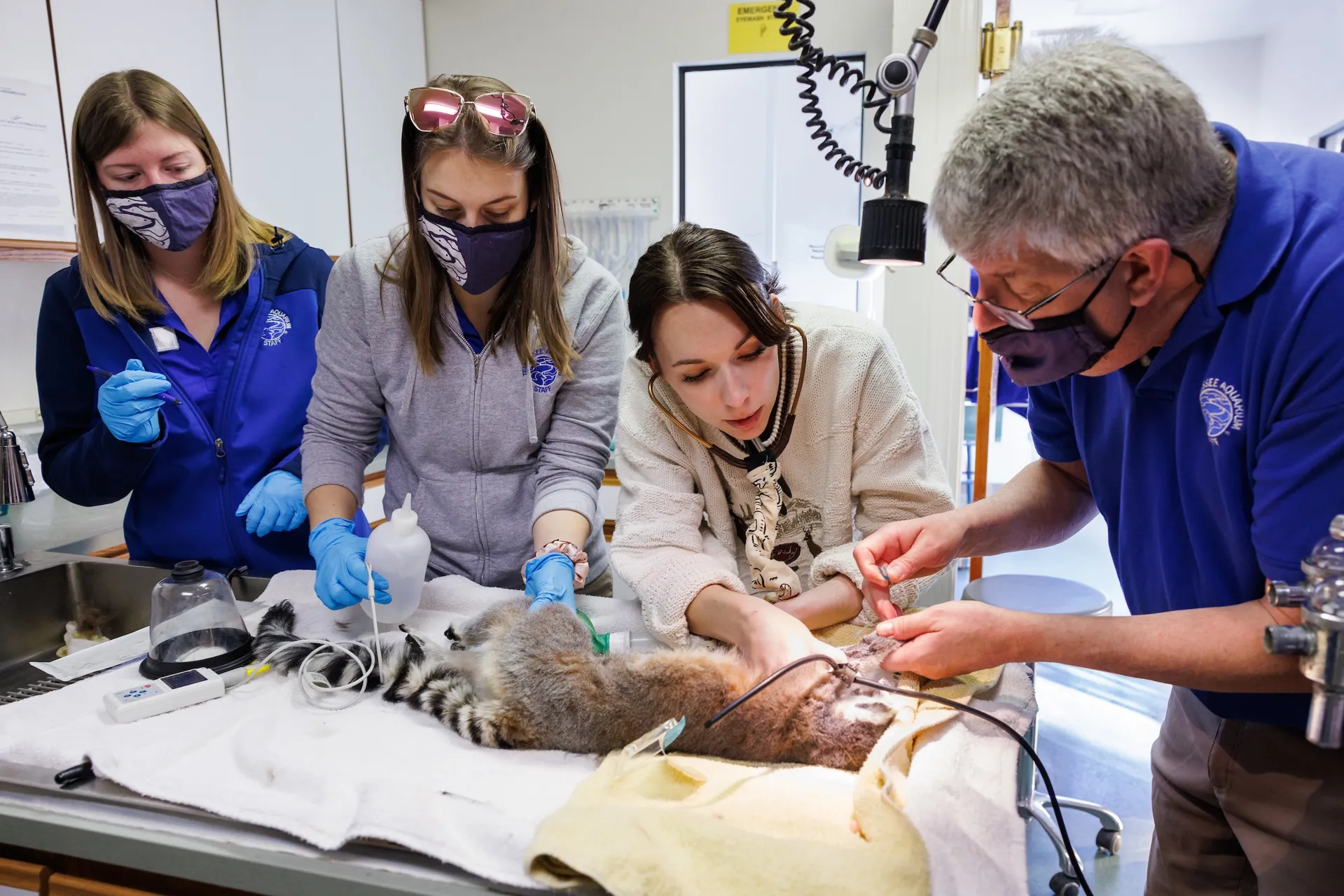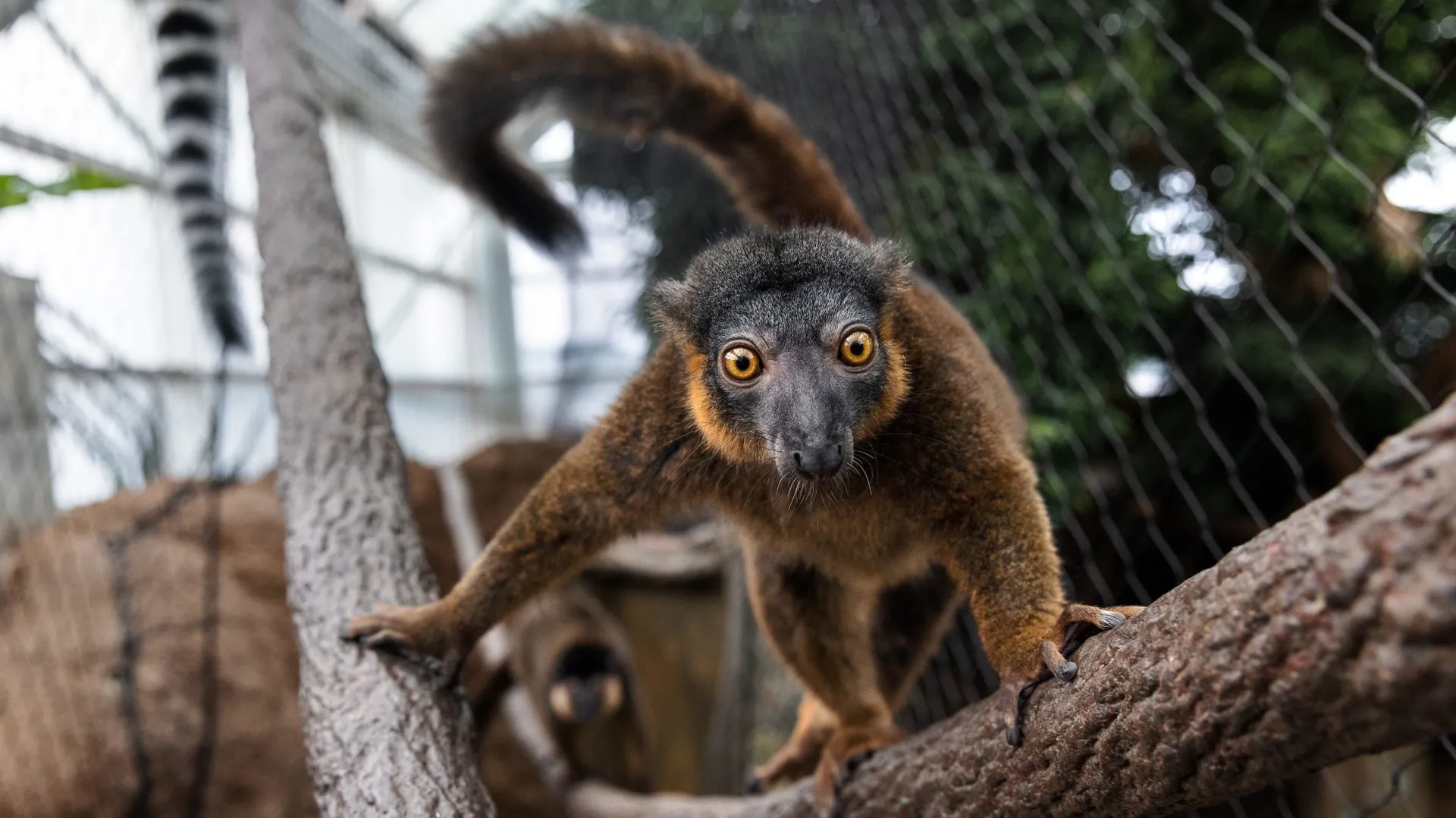For the team of lemur experts at the Tennessee Aquarium, nothing was merry about the holidays last December.
Instead of spending the days leading up to Christmas with their loved ones, animal care specialists Maggie Sipe, Sam Grote and Kaitlyn Boteler were in a veterinary facility anxiously tending to one of their charges.
The Friday before Christmas, Boteler was serving as holiday coverage for the Lemur Forest exhibit. While working in off-exhibit housing for the animals, she noticed unusual behavior and signs of distress in Jessie, a nine-year-old Red-collared Brown Lemur.
Jessie had difficulty keeping food down throughout the day. Despite attempting to hide an anti-nausea medication in her food as recommended by the Aquarium’s veterinarian, Dr. Chris Keller, Jessie refused to eat. The next day, Jessie’s appetite had all but disappeared.
Grote was called in to assist with transporting Jessie to Dr. Keller’s private veterinary practice atop Lookout Mountain. Sipe met them at the clinic, racing back to Chattanooga from a holiday trip to Atlanta.
For specialists who have dedicated their lives to the species in their care, cutting short a vacation or sacrificing time with loved ones is nothing less than what the animals deserve. When you interact with an animal every day — whether it’s a lemur, a sturgeon or a flying squirrel — the concept of “professional distance” becomes less and less realistic, Sipe says.
“We have a duty to them to do our very best by them and to give them the best life possible,” she says.
They don’t just care for the animals, she adds, they care about them.
“We spend time with them, and we ask them to trust us. We have to do right by them by caring. You can’t be distant.”
The first night
At the clinic, X-ray and ultrasonic imaging of Jessie showed signs of internal abnormalities that warranted closer inspection.
“We began an extensive exploratory procedure,” says Dr. Keller, who left his son, who was visiting him from out of town, to conduct the examination. “You literally try to get eyes on everything that is of concern while looking at the X-rays and ultrasound simultaneously.”
The two-hour examination revealed unusual material in Jessie’s bladder. After removing a sample of the material and performing a biopsy of the bladder wall, Jessie’s incision was closed and she was kept under observation during her recovery.
Her caretakers stayed in shifts to be with her. Sipe took the first watch, while the other care specialists went home to try to sleep for a few hours. They relieved Sipe at 2 a.m., staying with Jessie until after dawn before heading to the Aquarium to take care of the 10 other lemurs and five Radiated Tortoises in their care.
It was Christmas Eve.
For the next two days, Dr. Keller continued checking in on Jessie to evaluate her condition and administer medications. Her caretakers visited as well, bringing food and other items to make her more comfortable.
In the early morning hours the day after Christmas, her caretakers drove to the clinic to bring her back to the Aquarium for further recovery.
The next few weeks were a roller coaster for both lemur and care team.
The relapse
In the days following her return to the Aquarium, Jessie showed signs of improvement and a renewed appetite. While attempting to clean her habitat and administer an antibiotic, however, she began acting strangely and showed signs of backsliding. She was immediately taken back to Dr. Keller’s clinic for closer examination.
Despite being slow to recover from the anesthesia, the results of Jessie’s bloodwork weren’t concerning, and her bladder function seemed to have improved.
Once again, Jessie appeared to rally. Two weeks after her initial surgery, she was moved into a larger living space with limited artificial branches to discourage movement and promote restful inactivity.
Soon, however, her condition once again declined. She lost her appetite and began drinking less water. Worryingly, she strained to relieve herself but was unable to produce much urine.
We have to do right by them by caring. You can’t be distant.
Senior Animal Care Specialist Maggie Sipe


The frustration
For the care team, Jessie’s decline was as heart-wrenching as it was frustrating.
Unlike humans, who can explain their symptoms to a doctor, it’s often a guessing game trying to diagnose a sick or injured wild animal. For them, hiding symptoms is a kind of self-defense to avoid attracting the attention of would-be predators.
“People who don’t feel good are always complaining about what’s wrong with them, even if it’s just a hangnail,” Dr. Keller says. “Then, you have a situation like this where an animal has had catastrophic things happen to her, but she’s trying to protect herself by acting like everything’s OK.”
In Jessie’s case, the challenges of identifying and treating an illness were even more numerous.
Red-collared Browns are one of the least-exhibited of all lemurs, with only 60 individuals residing at 13 institutions.
This relative rarity in human care has left many blank spots in our understanding of Collared Lemurs’ natural history and anatomy beyond their median life expectancy, which is 23 years for individuals living at facilities accredited by the Association of Zoos and Aquariums (AZA).
“When there are so few of them around, you find yourself dealing with a lot of unknowns,” Sipe says.
Nevertheless, the Aquarium’s care team exhausted every avenue in search of a solution to Jessie’s condition. They poured through care manuals and painstakingly analyzed internal imaging looking for something they might have missed.
They also remained in constant contact with lemur experts at institutions around the country as well as other members of the AZA’s Species Survival Plan, the group responsible for managing all Red-Collared Brown Lemurs in human care.
In spite of this monumental effort, no one could figure out what was wrong with Jessie.
“Despite everything we did, there just wasn’t much information out there,” Dr. Keller says. “It seemed like we were on an island. We were trying to make logical decisions based on any kind of experience we could draw on from other situations.”
She’s trying to protect herself by acting like everything’s OK.
Veterinarian Dr. Chris Keller
The end
On Jan. 24, a month after first exhibiting her first signs of distress, Jessie was once again placed under anesthesia to perform additional bloodwork and further evaluate her condition. This time, an ultrasound found evidence of a blood clot blocking her bladder.
Realizing the pain caused by this obstruction and her slim chances for survival if they attempted to remove it, the care team decided to humanely euthanize Jessie while she was under anesthesia.
As a peaceful end to her discomfort, this was the right decision, but that didn’t make it any easier to come to, Dr. Keller says.
“I’ve been a veterinarian for 35 years, more than 30 of them at the Aquarium, and I can’t recall ever working harder for one animal here,” he says, voice choked and teary eyed. “It’s discouraging to do everything right — to do everything as hard as you possibly can — and still end up with this result.”
The better days
Nevertheless, in her four years at the Aquarium, Jessie served an important role as an ambassador for a species of lemur relatively few members of the public ever see, even at other zoos or aquariums.
For their part, the Aquarium’s lemur specialists say they will remember Jessie for the brighter moments during the four years she and exhibit mate, John, spent in Lemur Forest after moving to Chattanooga from the Bronx Zoo.
Despite a period of initial shyness, the pair quickly established themselves as inseparable tricksters, taking turns to outsmart their caretakers and pilfer treats before snuggling together for daytime naps.
Jessie was particularly fond of dried cranberries and nibbling on red-bud flowers, for which she would issue excited, anticipatory grunts before sitting down to snack, legs splayed to either side and long, brown tail stretched in front of her.
Despite her rambunctious spunk, Jessie was a calm and willing partner in learning to participate in her own care.
The lemur keepers worked to train Jessie to willingly enter her kennel, removing the element of stress from an important part of her care process. Sipe and Veterinary Assistant Shelby Ferguson were also finding success during weekly sessions teaching Jessie to voluntarily be ultrasounded.
With Jessie gone, John is now spending time in the company of Sprite and Snickers, a pair of male Ring-tailed Lemurs. The lemur specialists are carefully monitoring his behavior and are providing him with additional enrichment and training.
The days spent working alongside animals — learning the nuances of their behavior and the intricacies of their personality — are what make care specialists the first line of defense when it comes to the wellbeing of the Aquarium’s living collection, says Curator of Forests Kevin Calhoon.
“I’m always super-impressed with our team because they notice every tiny, little thing, which is so important,” he says. “They have to look at every tiny crease in their fur.
“With Jessie, everybody was so willing to spend their holidays here, come in on their days off or take turns to spend the night with her. I never even questioned that they would be willing to do that. This team went way, way beyond.”
